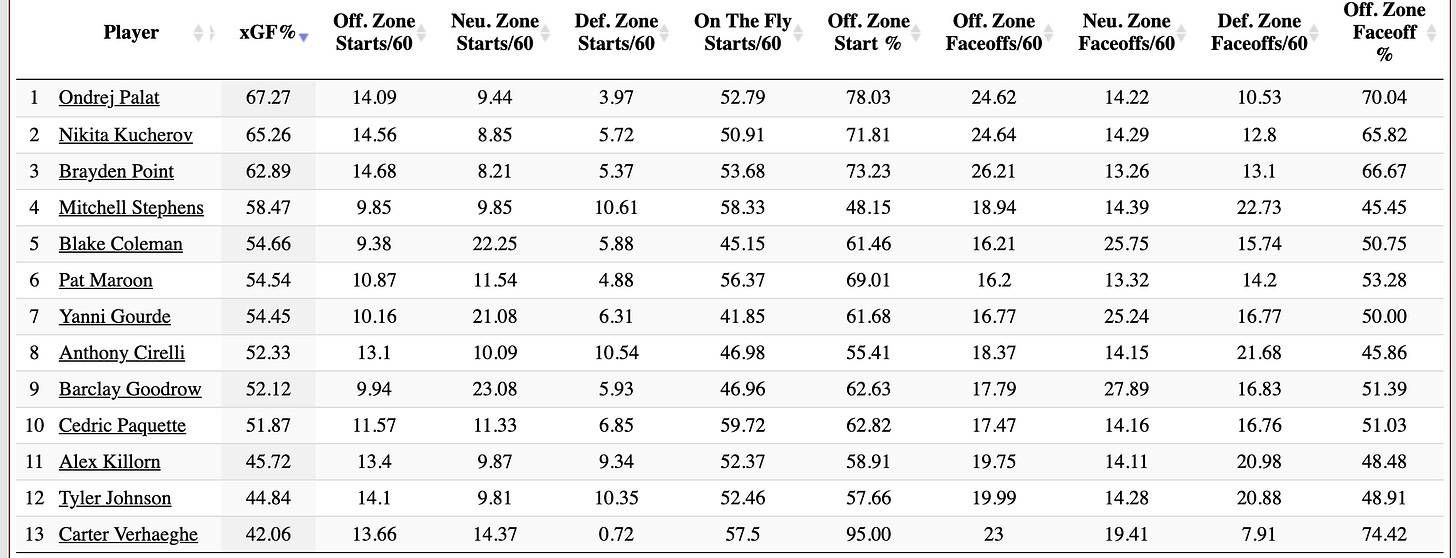How the Lightning built a remorseless matchup machine
Tampa's success in the playoffs goes beyond simply adding grit
Usually, contenders will do one of two things at the trade deadline - spend considerable draft assets to add another star or two to the fold, or trade nominal assets to add “grit”/veteran leadership/depth.
The Tampa Bay Lightning made a couple of moves outside of these conventions around the last trade deadline, trading for seeming depth pieces Barclay Goodrow and Blake Coleman for a relatively steep price (two first-round picks, and a first-round prospect Nolan Foote). Then they went and won the cup.
A common narrative I’ve noticed about these moves was the team added grit which helped them survive the tougher sledding in the post-season. It’s true, but I think it’s a bit more complicated than that.
Buying erasers
The secret is in the kinds of players the Bolts targeted and how they deployed them once they were in the fold.
Coleman and Goodrow are not the standard middle rotation grinders. Neither guy has ever scored more than 36 points in a year, but their value rests beyond counting stats. Instead, both players are above average play drivers and, specifically, defensive impact forwards.
In 2018-19, for instance, Blake Coleman spent over 40% of his even strength ice time against elite players according to Puck IQ, the second-highest ratio on the team behind Taylor Hall. He managed the second-best CF% rate against that level of competition, again only behind Hall.
If we look at Coleman’s season underlying numbers between 2018 and 2020s, we see he had the third-best relative CF% (total shot ratio) and fourth-best relative CA/60 (shots against/60 minutes of ice) amongst regular Devils’ skaters. This is despite spending a lot of time against stars and an aggregated offensive zonestart ratio of 41%.
Goodrow wasn’t quite as effective at overall play driving as Coleman over the same timeframe, but he was a shot and chance against eraser - his relative corsi against (-4.71 CA/60), scoring chances against (-4.16 SCA/60), and expected goals against (-0.25 XGA/60) rates were all top three amongst regular Sharks skaters.
So while these are guys who are nominally “gritty”, their grit results in real play driving and chance suppression, which isn’t always the case with many other middle or bottom rotation crash and bangers.
Leveraging depth
The Lightning are an intriguing team from a number of angles. They have a roster stacked with established stars at practically every position, but they also really like to give their big gun the high ground at even strength. For example, Steven Stamkos only spent about 27% of his even strength ice time against other stars last season, which is a ratio you usually see for third or fourth liners.
They can do this because of Anthony Cirelli, a Selke caliber center. Cirelli spends the most time on the team against elite opposition (38% in 2019-20) and he still comes out ahead.


This combination means opposing coaches are faced with akind of Sophie’s Choice when it comes to matchups - target Nikita Kucherov and Brayden Point or have your stars face one of the best two-way forwards in the league instead (leaving Kucherov to play against your second and third liners).
Goodrow and Coleman added to Lightning’s ability to make life miserable for opposing players (and coaches). How Tampa deployed the new additions and their middle rotation depth in the playoffs was textbook:
The Lightning’s top line saw an offensive zone start ratio over 65%+ during the playoffs, (and likely less time against other top lines than most other stars) and they owned expected goal ratios over 60% as a result (a ridiculously elite number).
To give their big guns the high ground, Tampa buried everyone else to one degree or another. Tyler Johnson and Alex Kilorn struggled a bit, but the rest of the roster - bolstered by the Coleman and Goodrow additions - finished in the black in terms of shots and chances (with the exception of Carter Verhaeghe, a rookie who appeared in only eight games).
So, yes, the Lightning added grit with Coleman and Goodrow. But they added functional grit that allowed them to effectively leverage their existing setup and roster rotation. These additions made it harder for the competition to get to the center of the ice and keep the puck in the offensive zone when Tampa’s support players were on the ice. This allowed stars to start practically every shift in the offensive zone and spend less time trying to saw things off against other top units.
Of course, the Lightning were favourites before the trade deadline additions thanks to their impressive bevy of talent. That said, Coleman and Goodrow meant easier sledding for the club’s snipers, which added another thumb on the scale of probability in the post-season. It paid off.
Resources used in this post:





